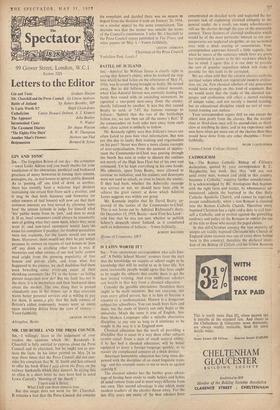BATTLE OF JUTLAND
SIR,—Admiral Sir William James is clearly right in saying that Scheer's object, when he realised the trap into which he had fallen on the afternoon of May 31, 1916, was to avoid being brought to battle. He turned away. But So did Jellicoe. At the critical moment, when Vice-Admiral Jcrram was correctly leading the battle fleet round with an encircling movement, he signalled a two-point turn-away from the enemy, shortly followed by another. It was this that caused Beatty to send, at 7.47, the famous message to Jellicoe 'Submit that the van of the battleships follow:me; we can then cut off the enemy's fleet.' If the commanders on both sides turn away from each other, close action is unlikely to follow.
Mr. Kennedy rightly says that Jellicoc's forces too often failed to pass him vital information. But was not this due to faulty fleet training and organisation on his part? Never was there a more classic example of over-centralisation. From the moment of deploy- ment the Commander-in-Chief was peering through the North Sea mist in order to discern the outlines not merely of the High Seas Fleet but of his own vast command. Yet he kept everything in his own hands. His admirals, apart from Beatty, were allowed to exercise no initiative; and his cruisers and destrdyers were not used to attack, or even to locate the enemy. If they had been, whether the Admiralty message was correct or not, we should have been able to achieve the great victory at dawn which Admiral James suggests was within our grasp.
Mr. Kennedy implies that Sir David Beatty ap- proved of the tactics of the Commander-in-Chief. This is not borne out by Admiral Richmond's diary. On December 13, 1919, Beatty—now First Sea Lord— told him that he was not sure whether to publish Scheer's despatch about Jutland, as it constituted such an indictment of Jellicoc.—Yours faithfully,










































 Previous page
Previous page